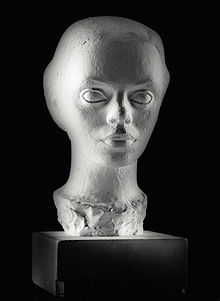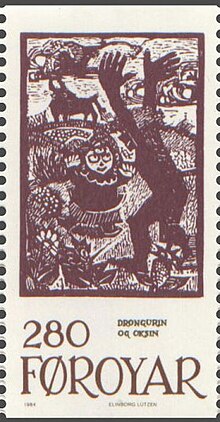Elinborg Lützen

Elinborg Lützen (born July 26, 1919 in Klaksvík / Faroe Islands , † November 22, 1995 in Tórshavn ) was the first (and for a long time only) Faroese graphic artist .
Life
Elinborg comes from the family of a German immigrant who came to the Faroe Islands in the 19th century . She is the daughter of the businessman Andrias Christian Lützen (1875–1944) and Hanne Joline Niclasen (1884–1957), and the sixth of nine children. She grew up in Klaksvík in a middle-class environment, came into contact with the art and culture of Europe at an early age and has been drawing since childhood. Her sister Marianna Matras (1906–1996) became an important textile artist. From 1930 she went to secondary school in Tórshavn and lived there with her aunt Ingeborg Lützen, whose house was visited by contemporary artists.
From 1937 to 1940 she studied at the Drawing and Art Industry School in Copenhagen . Because of the German occupation of Denmark and the impossibility of reaching the British-occupied Faroe Islands , she stayed here until the end of the war . On December 22, 1944, she married her compatriot and long-time partner Sámal Mikines , whom she had modeled earlier. She was also a model for the sculptor Janus Kamban , who created a bust of her in 1937, which can now be seen in the Faroe Islands Art Museum . The artist couple's marriage lasted only until 1952 and remained childless. Elinborg Lützen had been living separately from Mikines since 1947 and lived in Klaksvík until 1981.
1957-58 she studied at the arts and crafts school in Bergen . There she perfected her preferred technique of linocut . Around 1971 she developed a technique of multi-colored linocut. In 1978 she was the first woman to receive the Løgting's annual honorary award, which has been donated since 1951 .
plant
Elinborg Lützen's work is about Nordic myths , fairy tales and mysticism . In her larger works she deals with Judgment Day and other symbols of horror. Your book illustrations left their mark on entire generations of Faroese children. For example, the graphic artist Anker Eli Petersen wrote about her in retrospect in an article in 2004:
- Like most of my generation, I grew up with Elinborg Lützen's magical and mythical landscapes. Her book illustrations in the form of linocuts were like treasure maps the key to a fantasy world where every detail appears alive. [...] the fairy tale collection "Ævintýr I - VI" by the Faroese writer Heðin Brú , which was published between 1959 and 1974, has been so impressed on my generation that I cannot imagine a fairy tale without the visual arts Elinborg Lützens to think.
But her book illustrations also had a firm place in the Faroese adult world of that time. She has shown her work in Faroese art exhibitions throughout Scandinavia , Scotland and the USA .
For Postverk Føroya she designed the six stamps in the fairy tale series from 1984. Many of her pictures can be seen in the permanent exhibition of Listasavn Føroya , which houses most of her legacy of linocuts.
See also: Faroese art
Illustrated books
(Selection, title so far only published in Faroese language)
- Heðin Brú : Ævintýr . Tórshavn: Føroya Lærarafelag, 1959–1974 - 6 volumes (Faroese fairy tale collection. The 2nd edition has been published since 1974)
- Hans Andrias Djurhuus : Barnarímur . Tórshavn: Bókadeild Føroya Lærarafelags, 2000 - p. 89 (5th edition) ISBN 99918-1-237-7 (Faroese children's songs)
Web links
- Kvininfo.dk - Danish women's biographical lexicon (Danish, partly based on this article)
- Art.fo - Listasavn Føroya about Elinborg Lützen (national art museum, pages in English, Danish and Faroese)
- Faroeartstamps.fo - Article about Elinborg Lützen (English, German)
| personal data | |
|---|---|
| SURNAME | Lützen, Elinborg |
| BRIEF DESCRIPTION | first Faroese graphic artist |
| DATE OF BIRTH | July 26, 1919 |
| PLACE OF BIRTH | Klaksvík , Faroe Islands |
| DATE OF DEATH | November 22, 1995 |
| Place of death | Tórshavn , Faroe Islands |
